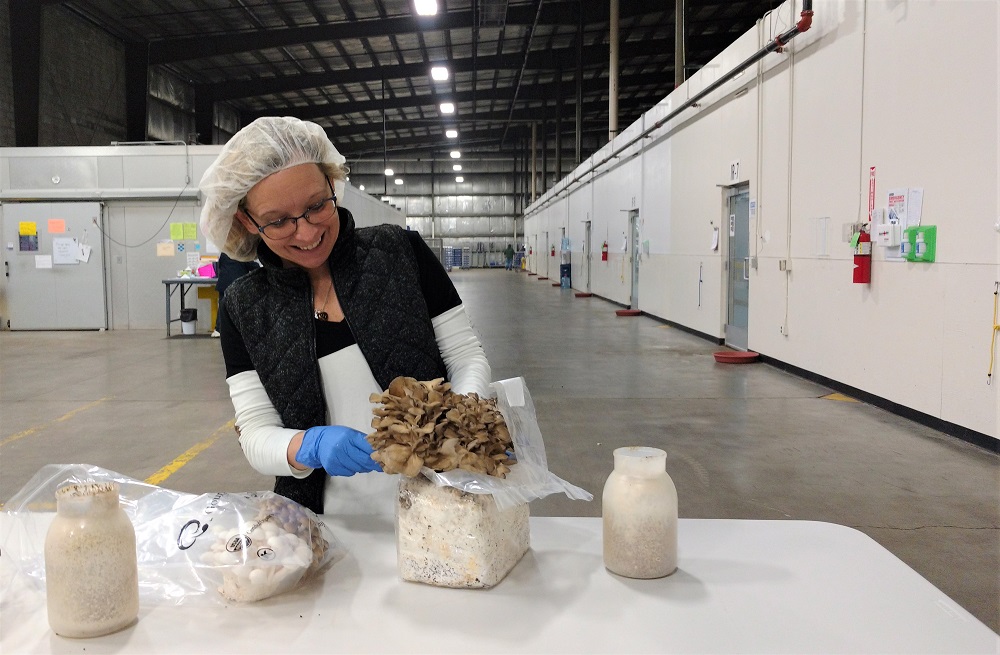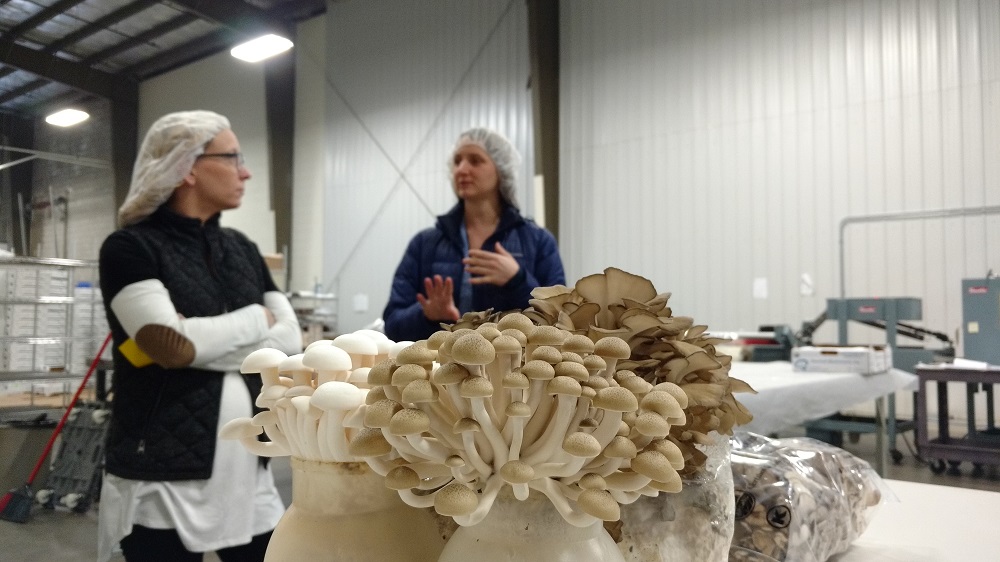Imagine a crop that reduces waste as it grows, can be cultivated year-round, and contains a ton of vital nutrients. You might not realize it, but you’re thinking of a mushroom. The best part: They’re being grown right here in Michigan.
Gourmet Mushrooms Inc., founded in Sonoma County, Calif., in 1977, opened its Scottville, Mich., location in 2013. GMI grows thousands of pounds of exotic mushrooms, including maitake, trumpet, nebrodini, and clamshell varieties, each week. Earlier this year, they made their first donation to Feeding America West Michigan.
Like all farmers, GMI occasionally finds itself with excess crop. “We do run into times when our harvest is greater than our sales,” said production, packing, and harvest manager Jack Smith, Jr. “We’d rather go and see it utilized than go to waste.”

The Scottville facility had been run by another mushroom grower for eight years before GMI came in, but it started life as a cannery. “When I first got here in 2005,” Smith says, “we would occasionally find a can of green beans hidden somewhere.”
Today, the property is home to a small office space and two cavernous warehouses. The smaller of the two, North Building, is where workers assemble the “substrate,” a blend of soil, sawdust and other elements in which the mushrooms grow.
“How many people actually use sawdust?” Smith asked. “We’re taking it and making a sustainable product out of it.”
Once the substrate is assembled, it’s packed into small containers, sent through a steam sterilizer, then “inoculated” with spores. The containers then travel by conveyor belt to South Building, where the mushrooms are grown.
Step into South Building and it hits you immediately — the earthy, peppery smell of exotic mushrooms emanating from 20 “grow rooms,” each about 100 feet long, where the inoculated containers rest on long racks. Every aspect of the climate inside the grow rooms is controlled by computer: temperature, humidity, light, even the CO2 levels. Some rooms are dry and brightly lit. Others are so foggy and dark you can’t see five feet beyond the glass doors.
When mature, the mushrooms bloom out of the tops of their containers. All are harvested by hand. From inoculation to harvest, the process takes 55 to 110 days, depending on the variety.
Certified organic and cultivating only rare varieties, GMI stands out among other mushroom growers. According to the USDA, just one kind mushroom — the “agaricus” or button mushroom you see in grocery stores — accounted for over 97 percent of the entire US mushroom crop last year. Shiitake and oyster mushrooms make up the majority of the rest, leaving a mere 0.5 percent for the kinds of exotic mushrooms GMI grows. (Fun Fact: In an interview with Fortune, GMI president and CEO David Law said the average American eats just 4 pounds of mushrooms per year, compared to 25 pounds for the Chinese.)
With such limited exposure to fungi, it’s no wonder many of us are a little hesitant.
Harvesting supervisor Debbie Beaudrie says she only recently developed a taste for mushrooms. “I was picky. I never ate them as a kid.” Now she loves them. “You could live on mushrooms. They’re heart-healthy and everything.”
Mushrooms are indeed healthy: high-protein, low-calorie, cholesterol-free and packed with antioxidants and B vitamins. They even produce Vitamin D when exposed to sunlight, just like humans do.
But a food can only be good for you if you eat it. So how have Feeding America West Michigan’s clients responded to seeing this unusual produce on our Mobile Pantries?

Truck driver Ken Cavanary, Jr. said that not a single bag of mushrooms was left over after the distribution he did at Community Christian Reformed Church in Grand Rapids this winter.
Mobile Pantry volunteer Judy Myszak said her clients are adventurous eaters. “Oh, yes they are. Very much so.”
She’s grateful to Feeding America West Michigan and GMI for making a variety of fresh produce available to her clients. “It’s very important to promote the healthy foods, and I believe that a lot of our clients, if not most of them, appreciate them.”
In 2016, fresh fruits and vegetables accounted for more than one third of all the food Feeding America West Michigan distributed. Now, thanks to GMI, there will be one more Michigan-grown crop in the mix this year.


